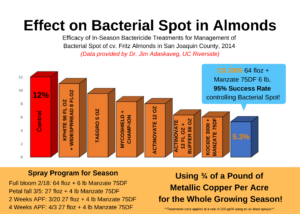Bacterial Spot Control in Almonds with Magna-Bon CS 2005
Bacterial Spot, caused by Xanthomonas arboricola pv. pruni, continues to challenge almond growers — leading to defoliation, reduced yields, and lower nut quality. In recent University of California field trials, Magna-Bon CS 2005 delivered up to 95% control of Bacterial Spot, giving growers a cleaner, more sustainable solution that fits both conventional and organic programs.
🌱 Field Trial Details
Research conducted by:
Dr. Jim Adaskaveg – University of California, Riverside
| Timing | Growth Stage | Treatment & Rate |
|---|---|---|
| February 18 | Full Bloom | CS 2005 – 64 oz + Manzate® 75DF – 6 lbs |
| March 5 | Petal Fall | CS 2005 – 27 oz + Manzate® 75DF – 4 lbs |
| March 20 | 2 Weeks After Petal Fall | CS 2005 – 27 oz + Manzate® 75DF – 4 lbs |
| April 3 | 4 Weeks After Petal Fall | CS 2005 – 27 oz + Manzate® 75DF – 4 lbs |
💪 Results That Deliver
✅ Up to 95% control of Bacterial Spot under high disease pressure
🌿 Significant reduction in defoliation and visible leaf spotting
🌸 Improved canopy health and nut quality through harvest
♻️ Less metallic copper per acre than conventional copper programs
🧴 OMRI-Listed formula fits both sustainable and conventional management
CS 2005’s advanced in-solution copper sulfate pentahydrate formulation provides powerful, uniform coverage with reduced residue and environmental impact — ensuring stronger, healthier trees and long-lasting protection.
🚀 The Bottom Line
Backed by university research and proven field performance, Magna-Bon CS 2005 offers a next-generation approach to managing Bacterial Spot in almonds.
Growers can expect powerful efficacy, cleaner foliage, and sustainable results — all with less copper input.
Click here to see the Information Sheet on Bacterial Spot on Almonds!
Want trial data, labels, or local rep support? Contact your Magna-Bon sales representative or visit our Research page for full study details and recommended best practices.

